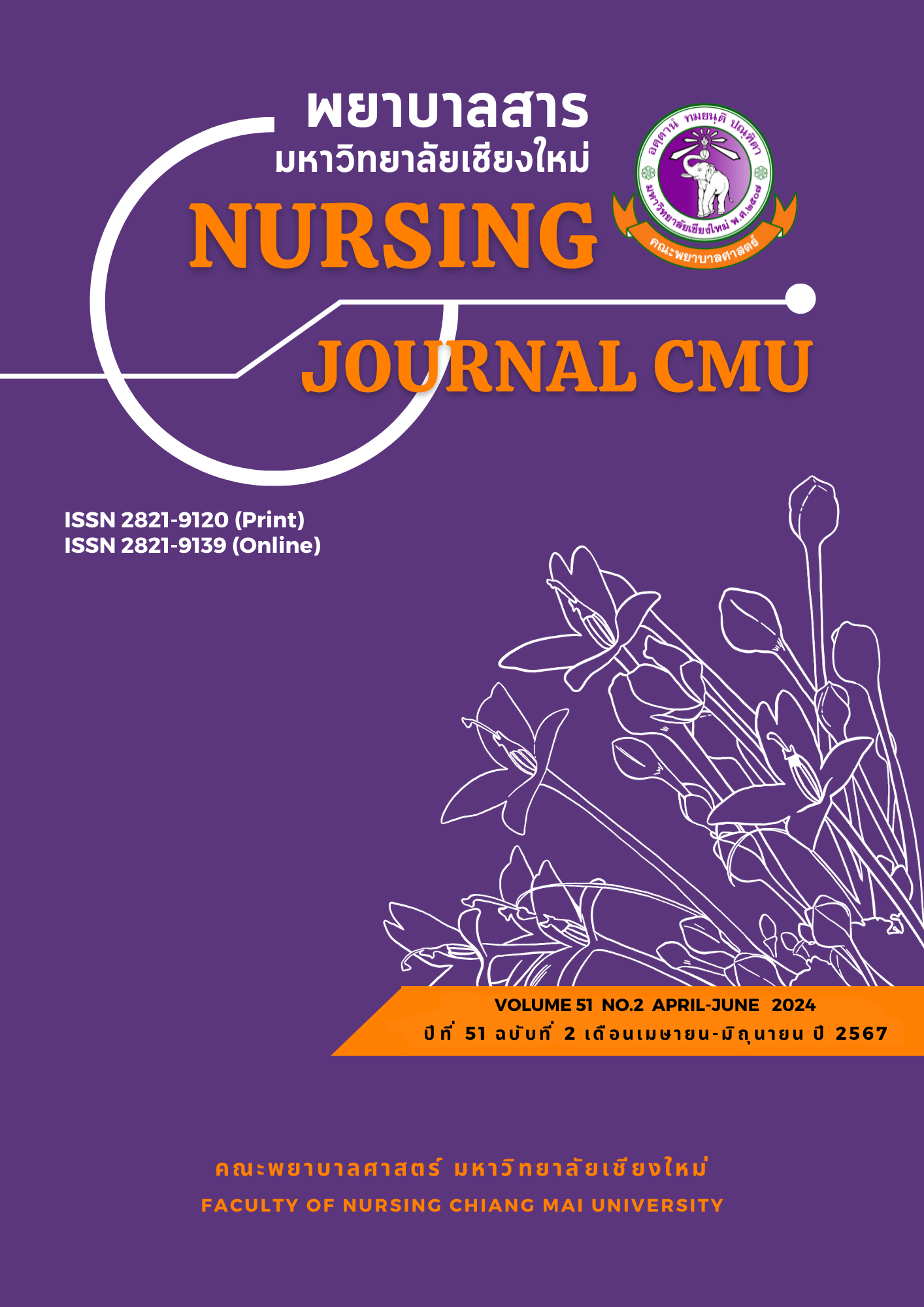ผลของโปรแกรมการมีส่วนร่วมของครอบครัวต่อการป้องกันการล่วงละเมิดทางเพศ ในผู้ปกครองของเด็กหญิงชั้นมัธยมศึกษาตอนต้นในชุมชน
คำสำคัญ:
การมีส่วนร่วม, โปรแกรมการมีส่วนร่วมของครอบครัว, การป้องกันการล่วงละเมิดทางเพศ, ผู้ปกครอง, เด็กหญิงชั้นมัธยมศึกษาตอนต้นบทคัดย่อ
การป้องกันการล่วงละเมิดทางเพศในเด็กหญิงชั้นมัธยมศึกษาตอนต้น โดยการมีส่วนร่วมของครอบครัวมีความจำเป็นอย่างยิ่ง การศึกษาครั้งนี้เป็นการวิจัยกึ่งทดลอง แบบสองกลุ่ม มีวัตถุประสงค์เพื่อศึกษาผลของโปรแกรมการมีส่วนร่วมของครอบครัว ต่อการป้องกันการล่วงละเมิดทางเพศ ในผู้ปกครองของเด็กหญิงชั้นมัธยมศึกษาตอนต้นในชุมชน กลุ่มตัวอย่างคือผู้ปกครองเด็กหญิงชั้นมัธยมศึกษาตอนต้นจำนวน 42 คน แบ่งเป็นกลุ่มควบคุมและกลุ่มทดลองกลุ่มละ 21 คน เครื่องมือที่ใช้ในการวิจัยประกอบด้วย โปรแกรมการมีส่วนร่วมของครอบครัว ที่พัฒนามาจากแนวคิดทฤษฎีการมีส่วนร่วมของโคเฮน และอัฟฮอฟ คู่มือการป้องกันการล่วงละเมิดทางเพศในเด็กหญิงชั้นมัธยมศึกษาตอนต้นสำหรับผู้ปกครอง และแบบสอบถามการป้องกันการล่วงละเมิดทางเพศของผู้ปกครองนักเรียนเด็กหญิงชั้นมัธยมศึกษาตอนต้น เครื่องมือได้รับการตรวจสอบโดยผู้ทรงคุณวุฒิจำนวน 6 ท่าน มีค่าดัชนีความตรงตามเนื้อหา เท่ากับ .94 และค่าความเชื่อมั่นเท่ากับ .95 วิเคราะห์ข้อมูลด้วยสถิติเชิงพรรณนา สถิติ Paired t-test และ Independent t-test
ผลการวิจัยพบว่า ภายหลังเข้าร่วมโปรแกรมฯ 1) ผู้ปกครองกลุ่มที่ได้รับโปรแกรมฯ มีคะแนนเฉลี่ยการป้องกันการล่วงละเมิดทางเพศสูงกว่าก่อนได้รับโปรแกรมฯ (t = 5.57, p < .001) และ 2) ผู้ปกครองกลุ่มที่ได้รับโปรแกรมฯ มีคะแนนเฉลี่ยการป้องกันการล่วงละเมิดทางเพศสูงกว่ากลุ่มที่ไม่ได้รับโปรแกรมฯ (t = 5.89, p < .001)
ผลการศึกษาครั้งนี้แสดงให้เห็นว่า โปรแกรมการมีส่วนร่วมของครอบครัวมีผลทำให้การป้องกันการล่วงละเมิดทางเพศในผู้ปกครองของเด็กหญิงชั้นมัธยมศึกษาตอนต้นในชุมชนเพิ่มขึ้นได้ ดังนั้นควรมีการนำโปรแกรมการมีส่วนร่วมของครอบครัวนี้ มาใช้เพื่อป้องกันการล่วงละเมิดทางเพศของเด็กหญิงชั้นมัธยมศึกษาตอนต้นในโรงเรียนอื่นต่อไป
References
Babatsikos, G. (2010), Parents' knowledge, attitudes and practices about preventing child sexual abuse: A literature review. Child Abuse Review, 19(2), 107-129. https://doi.org/10.1002/car.1102
Cashin, A., & Weissbourd, R. (2017). Sexual harassment among teens is pervasive. Here’s how parents can change that. https://www.washingtonpost.com/news/parenting/wp/2017/10/16/sexual-harassment-among-teens-is-pervasive-heres-how-parents-can-help-change-it/
Chanphong, J. (2019). Parent-child sexual communication. Nursing Science Journal of Thailand, 37(1), 4–16. https://he02.tci-thaijo.org/index.php/ns/article/view/180915 (in Thai)
Chantrayotagorn, L., & Udkhammee, K. (2021). Effects of professional nurses participation program in perioperative nursing care to patient safety surgery Phrae Hospital. Journal of the Phrae Hospital, 29(1), 28-38. https://thaidj.org/index.php/jpph/article/view/10680/9404
Chulpan, P. (2017). Sexually abuse. http://www2.yothinburana.ac.th/website/Teacher_Works/05_Health/preeda/book4.pdf (in Thai)
Cohen, J. (1992). Statistical power analysis. Current Directions in Psychological Science, 1(3), 98–101. https://www.doi.org/10.1111/1467-8721.ep10768783
Cohen, J. M., & Uphoff, N. T. (1981). Rural development participation: Concept and measure for project design implementation and evaluation: Rural development committee center for international studies. Cornell University Press.
Cohen, J. M., & Uphoff, N. T. (1986). World development. McGraw-Hill.
Committee for Prevention and Resolution of Teenage Pregnancy Problems. (2016). Adolescent pregnancy prevention and solution to the problem act, B.E. 2560-2569 (2017-2026), act for prevention and solution of the adolescent pregnancy problem, B.E. 2559 (2016). http://203.157.71.139/group_sr/allfile/1611217699.pdf (in Thai)
Department of Mental Health. (2018). The Ministry of Public Health joins forces to end violence against children and women by setting up “dependency centers” in all levels of health care facilities across the country. https://www.dmh.go.th/news-dmh/view.asp?id=28353 (in Thai)
Guo, S., Chen, J., Yu, B., Jiang, Y., Song, Y., & Jin, Y. (2019). Knowledge, attitude, and practice of child sexual abuse prevention among parents of children with hearing loss: A pilot study in beijing and Hebei Province, China. Journal of Child Sexual Abuse, 28(7), 781–798. https://doi.org/10.1080/10538712.2019.1627688
Jaikla, P., & Jaikla, A. (2019). Nurses’ role in child sexual abuse. Journal of Health Science. Research, 13(2), 128–139. https://he01.tci-thaijo.org/index.php/JHR/article/view/233447 (in Thai)
Khanjari, S., Modabber, M., Rahmati, M., & Haghani, H. (2017). Knowledge, attitudes and practices among parents of school-age children after child sexual abuse prevention education. Iran Journal of Nursing, 29(104), 17-27. https://www.sid.ir/paper/114377/en
Khoori, E., Gholamfarkhani, S., Tatari, M., & Wurtele, S. K. (2020). Parents as teachers: Mothers' roles in sexual abuse prevention education in Gorgan, Iran. Child Abuse & Neglect, 109, 104695. https://doi.org/10.1016/j.chiabu.2020.104695
Kirdin, S., Vuthiarpa, S., & Bunthumporn, N. (2019). Effects of life skills program on knowledge and life skills to prevent sexual assault in female secondary school students. The Journal of Psychiatric Nursing and Mental Health, 33(1), 128-145. https://he02.tci-thaijo.org/index.php/JPNMH/article/view/185666/130523 (in Thai)
Klatthong, S. (2006). Program development on prevention skills against sexual assault among school aged children in Maung District, Uttaradit Province [Unpublished doctoral dissertation]. Mahidol University. (in Thai)
Mileva, B., Goshev, M., & Alexandrov, A. (2020). Crimes against children: Sexual violence. Science & Research, 5(2), 42-48. https://www.sandtr.org/journal/5/95.pdf
Pangsorn, A., & Sithicharoon, W. (2018). Demographic profiles of sexual abused cases in HRH princess Maha Chakri Sirindhorn medical center. Ramathibodi Medical Journal, 41(1), 38-47. https://he02.tci-thaijo.org/index.php/ramajournal/article/view/98466
Rudolph, J., & Zimmer-Gembeck, M. J. (2018). Parents as protectors: A qualitative study of parents' views on child sexual abuse prevention. Child Abuse & Neglect, 85, 28–38. https://doi.org/10.1016/j.chiabu.2018.08.016
Russell, D. H., Trew, S., Harris, L., Dickson, J., Walsh, K., Higgins, D. J., & Smith, R. (2024). Engaging parents in child-focused child sexual abuse prevention education strategies: A systematic review. Trauma, Violence, & Abuse, e15248380241235895. https://doi.org/10.1177/15248380241235895
Srithongkun, W., Auemaneekul, N., Powwattana, A., & Taechaboonsermsak, P. (2019). The effects of a lifeskills program with parental support on sexual abuse prevention of elementary school girls. Journal of Public Health Nursing, 33(Online), 1–20. (in Thai)
Tassaneeyarat, S., & Rodcumdee, B. (2014). The effect of child sexual abuse prevention program on intention to conduct preventive behaviors of primary school girl. Journal of Nursing Science Chulalongkorn University, 26(1), 1-10. (in Thai)
UN Thailand. (2016). SDGs success stories in Thailand - prevention and solution of the adolescent pregnancy problem act A.D. 2016. https://thailand.unfpa.org/en/publications/sdgs-success-stories-thailand-prevention-and-solution-adolescent-pregnancy-problem-act (in Thai)
Vijitpreecha, A. (2020). Paweena reveals the statistics of the year 2020, more children were raped than the year and found the youngest age 2 years and 10 months. https://www.naewna.com/local/541714 (in Thai)
World Health Organization. (2022). Violence against children. https://www.who.int/news-room/fact-sheets/detail/violence-against-children
Xie, Q. W., Qiao, D. P., & Wang, X. L. (2016). Parent-Involved prevention of child sexual abuse: A qualitative exploration of parents’ perceptions and practices in Beijing. Journal of Child and Family Studies, 25, 999–1010. https://doi.org/10.1007/s10826-015-0277-5
Downloads
เผยแพร่แล้ว
How to Cite
ฉบับ
บท
License
Copyright (c) 2024 พยาบาลสาร มหาวิทยาลัยเชียงใหม่

This work is licensed under a Creative Commons Attribution-NonCommercial-NoDerivatives 4.0 International License.
บทความที่ได้รับการตีพิมพ์เป็นลิขสิทธิ์ของวารสารพยาบาลสาร
ข้อความที่ปรากฏในบทความแต่ละเรื่องในวารสารวิชาการเล่มนี้เป็นความคิดเห็นส่วนตัวของผู้เขียนแต่ละท่านไม่เกี่ยวข้องกับมหาวิทยาลัยเชียงใหม่ และคณาจารย์ท่านอื่นๆในมหาวิทยาลัยฯ แต่อย่างใด ความรับผิดชอบองค์ประกอบทั้งหมดของบทความแต่ละเรื่องเป็นของผู้เขียนแต่ละท่าน หากมีความผิดพลาดใด ๆ ผู้เขียนแต่ละท่านจะรับผิดชอบบทความของตนเองแต่ผู้เดียว





